The Best Handheld Red Light Therapy Device Of 2021 & 2022: Epic Review
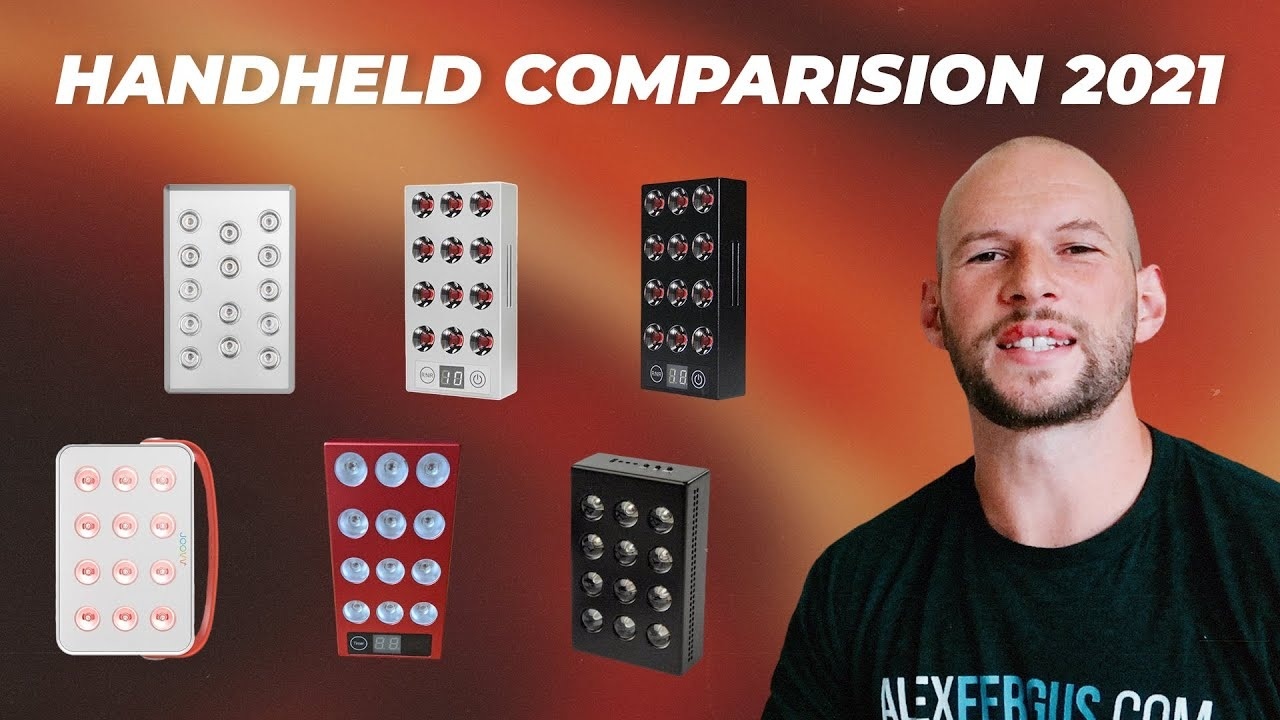
Welcome to my 2021/2022 red light therapy handheld review blog post.
First things first though...
Let me give you a little background:
You probably know about my 2019 red light therapy review blog post and YouTube video.
The blog post you're currently reading is a followup to that series, specifically the red light therapy handheld line offered by many companies today.
Between 2017-2019, when I was already present in the red light therapy space, few companies offered handheld option. Back then, only the Joovv Go 1.0 was offered on the market.
Today, that's different, and most of the companies are offering a handheld option.
Hence, my review of the best red light therapy handheld products on the market. If you're not aware of what red light therapy is then I recommend reading:
- Everything You Need To Know About Red Light Therapy
- 36 Powerful Red Light Therapy Benefits
- Red Light Therapy Resource & Discount Page
- How Does Red Light Therapy Work? Physics, Photons & Physiology 101
- Everything You Need To Know About Red Light Therapy Dosing
Those blogs should give you all the background information you need - although they require a lot of reading!
So, are you ready for my 2021 handheld review?
First off, if you're interested in watching the YouTube video, check my video review of the handheld red light therapy devices below:
If you like to read the review of these 7 handheld devices, continue reading:
Let's explore what I mean with "handheld" first...
I define red light therapy "handheld" devices as devices that you can hold in your hand while treating smaller areas of your body. These handheld devices are an excellent choice to take with you on travel.
But, these handheld devices have other use cases as well:
If you've got sore biceps muscles from training very hard, for instance, or a shoulder injury, or some tension in your neck, then handheld devices are a great choice for treatment.
Alternatively, you can use a smaller portable unit at the couch in the evening, for instance.
But, handheld devices are not for everyone!
Here's why:
If you want to treat your entire body, or large parts of it, I wouldn't recommend a handheld device and I'd suggest using a body panel or maximum/mega-size panel instead.
That link I've just quoted shows you the best full red light therapy devices I recommend, which can treat large areas of your body such as your back, legs, chest and stomach, in the minimum amount of time!
Having gotten that topic out of the way, let's dig into my testing methodology for the handheld devices in the next section.
(If you want to skip this very wordy review and know which device is the winner straight away, click HERE.)
How I've Tested These Devices - Methodology
In total, I've compared 7 handheld red light therapy devices.
Let me explain why I've tested 7 of them in total.
As you might know, more and more companies are entering the red light therapy space. A rough estimate of mine is that about 50-100 serious companies are competing against each other right now. Many of these companies are also offering handheld options.
For my review, I've reached out to the most prestigious companies out there, which either 1) had been around for a while or; 2) had gotten very positive reviews. These companies then sent me a unit for testing/reviewing.
Once I got these units, I compared them across price, shipping, power output, EMF levels, battery life, a category of "everything else".
Also, if you're interested in buying any of these panels, discount code ALEX saves you money with most of these companies. To make my incentives and potential financial gains from this review fully transparent, I've included the following disclaimer below:
*** Affiliate Disclosure ***
I am affiliated with 6 of these 7 red light panel companies. That means if you purchase any of these products by clicking any of the links in the blog below OR use discount code ALEX then I receive a small commission. There is no cost to you and you save money instead! This method entails a win-win (you get a discount and I get a small commission)for the both of us. This commission, in turn, helps me fund reviews like this one. Also, I wanted to be affiliated with all possible companies to remove any review bias. We know red light therapy works, my goal is simply to help you make an informed decision when buying a red light panel.
The 7 Handheld Panels: Infraredi vs. Light Path LED vs. BluBlox vs. Rouge vs. Joovv vs. Mito Red vs. GembaRed
Here are the 7 handheld devices I reviewed:
(The full review is readable in the next sections)
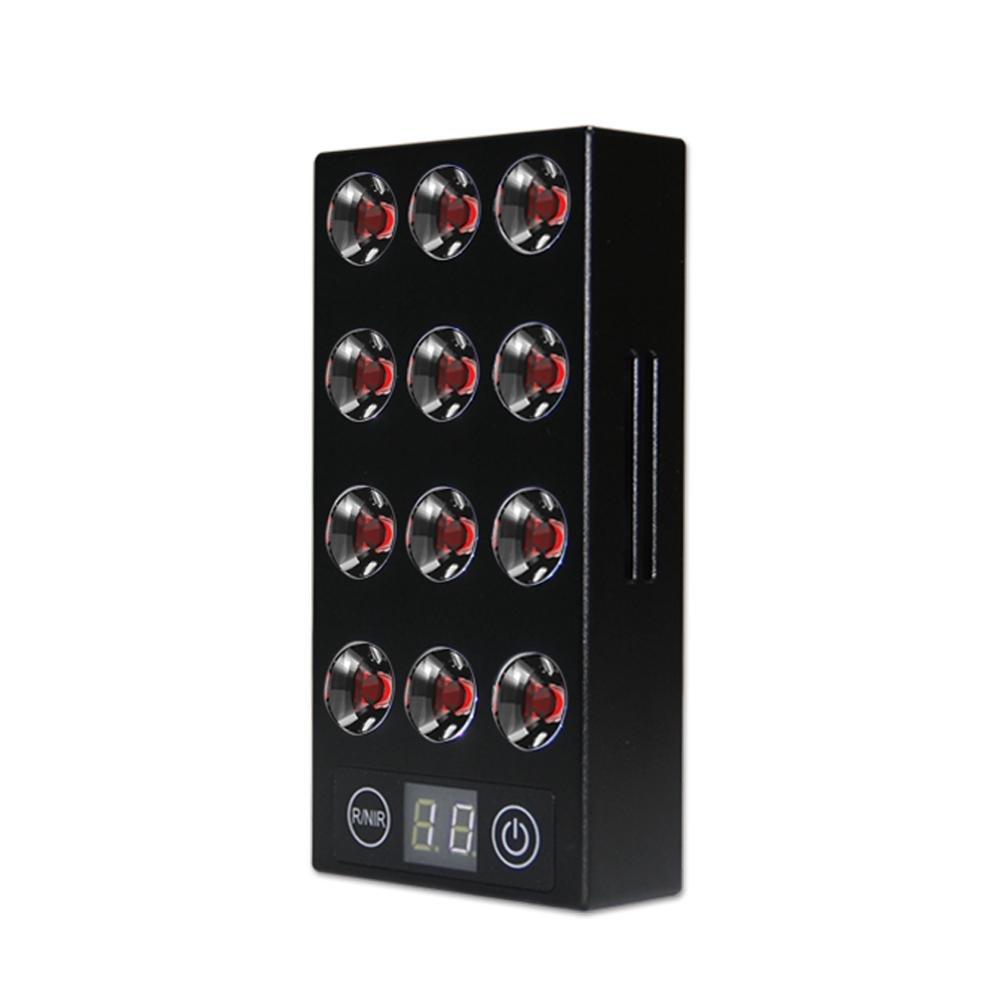
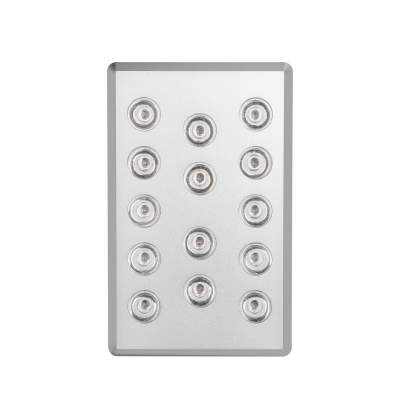


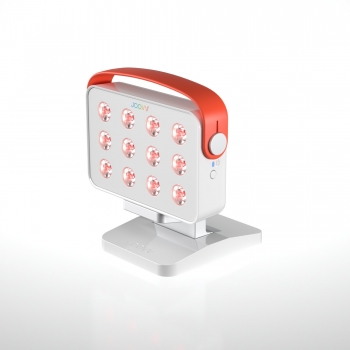
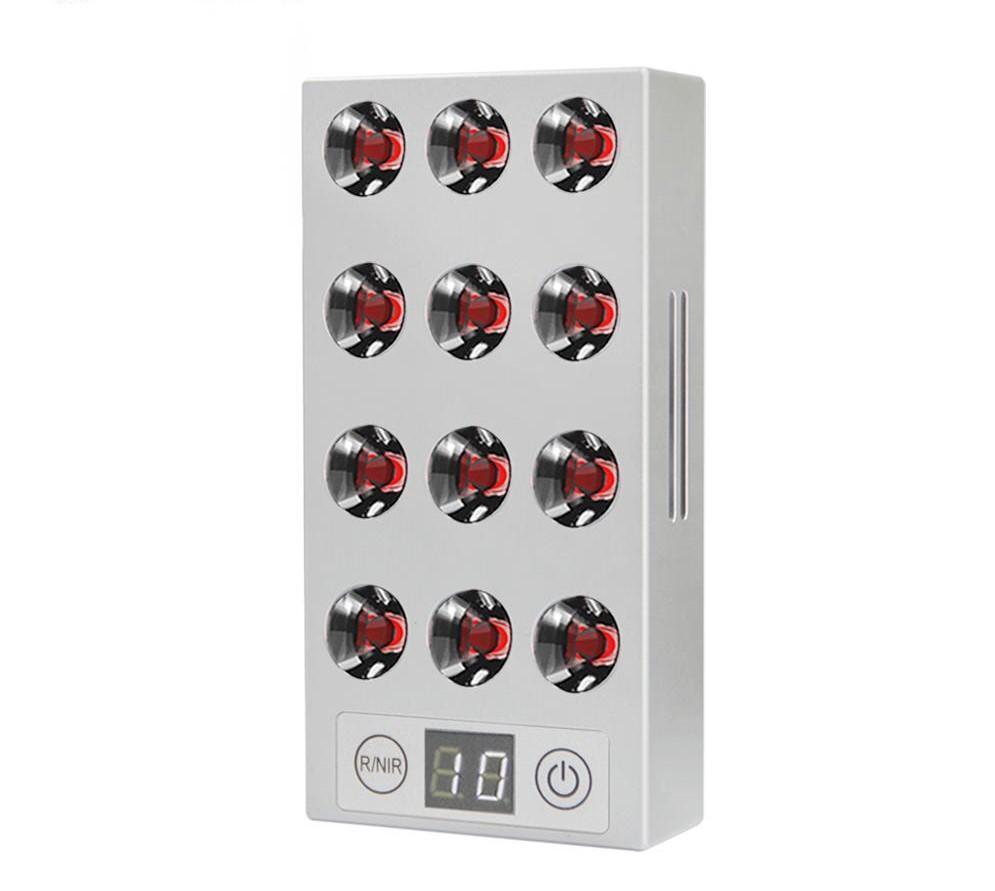

Again, discount code ALEX saves you money on almost all of these devices! If you want to skip the review and know which device is the winner straight away, click HERE.
Next up, let's move on to considering which option is best for you:
The Comparison & Full Review
Naturally, testing 7 different handheld panels takes time. I've played around with all of these 7 handheld panels and I've also thought a long time about the best way to review each and every one of them.
Please be aware that no review criteria makes everybody equally happy. Some companies and consumers might want me to put a lot more emphasis on price, while others think that power output alone is much more important. And if you're EMF-sensitive, you're automatically going to give a higher weight to the EMF outcome compared to other categories.
(More on individual preferences at the bottom of this review!)
As stated before, I compared these devices across price, shipping, power output, EMF levels, battery life, a category of "everything else". All of these domains mean that there will be 5 review rounds.
After each review round, I'll give a sub-total for the score for each panel. At the end, I'll give you the final outcome!
Round 1: Price & Shipping & Discounts
In this round, I've also unboxed all of the devices. You can see a more extensive version of the unboxing in my review video HERE.
In this written blog, I'll mainly focus on the price, shipping, and discounts. Again, the unboxing of all 7 products can be viewed in the video HERE.
Here's what the outcome of this first round was:

* Prices are with discount code ALEX, where applicable.
** Prices include shipping price to mainland USA. International shipping prices may be higher!
If you're interested in more details about my thoughts during this round, here is what I found regarding all of these panels. These observations concern the unboxing/first impressions I had with each device:
- The Infraredi Micro has twelve 5-Watt LEDs, a short power cable, a timer, and the option to select between red or infrared or both. The device is also super silent and has a battery indicator at the back. This is a pretty simple option! The device comes with carry pouch as well. Nevertheless, the device looks very simple and effective, which can be a benefit! The device comes in 3 color options, black, silver, and red.
- The Light Path LED Mini has free USA shipping. The device is a little bit larger than the Infraredi Micro. Eye protection goggles and a USB lightning cable are included. The device has 14 LEDs and comes in a 660+850 nanometer option, and also a 660 nanometers & blue light option. I've received and tested the latter option. This device also has a battery charge indicator at the bottom. Soft carry pouch included.
- Next up, the Boncharge (Formerly BLUBlox Hive Mini. The Hive Mini comes with a somewhat bigger carry pouch. Comes with power point and USB charger. The device has twelve 3-Watt LEDs of 660 and 850 nanometer lights. Power indicator is on the bottom. Red and infrared can be used independently.
- Then there's the Rouge Nano. Comes with free worldwide shipping. The battery charger / power point is quite bulky. Eye goggles are included. The carry pouch is soft-shell. Aesthetically, the device looks a little bit different than all the other devices in this review round. The device is also made from solid metal, which may be suboptimal if you're taking it with you in a carry on bag for travel. The twelve 5-Watt LEDs provide 660 and 850 nanometers
- The Joovv Go 2.0 is the second generation of Joovv's handheld devices. My first impressions video of the Joovv Go 2.0 can be viewed HERE. Green eyeglasses are included with this product, which are better than the black ones coming with all other products. The manual is also better than most if not all of the competition. The carry case is semi-hard shell. The battery power point looks a bit cheap and looks to come right from the Chinese factory, which is a bummer. The device itself is very nice, made from tough plastic. The device comes with 12 LEDs of 660 and 850 nanometers. All the ports and buttons on the device are a bit confusing to me, such as a Bluetooth port. The Go 2.0 also has a ambient mode, for background lighting.
- Then, the Mito Red Mito Mobile Flex has exactly the same design as the Infraredi Micro. Even the pouch is the same. And the buttons and LEDs are the same. As the Infraredi, the Mobile Flex comes in a combination of 660 and 850-nanometer wavelengths. USB-lightning charger is included. The device comes in 3 color options, black, silver, and red. With this device it's possible to select between red light only, near-infrared only, or both wavelengths combined.
- Lastly, there's the GembaRed Spazer. Once more, this device has exactly the same design as the Mito Red Mobile Flex and the Infraredi Micro. You might assume these devices are exactly the same but that's not the case! The GembaRed is quite thin and very light. Reason? The GembaRed doesn't come with a battery inside, so you can only use the device from a power outlet. Therefore, the device comes with several power cables so that it's easy to use in all circumstances. The power unit and cable are very big and almost as big as the device. And just like the Mito Red Mobile Flex and Infraredi Micro, this device comes in 3 colors, red, silver, and black.
My overall findings of this round?
As you can see, the Joovv Go 2.0 is by far the most expensive panel, costing almost 60% more than the second option at $485. The GembaRed Spazer only costs $180, which, doesn't have a battery and can only be used from a power outlet.
Most units are around the mid-$200 range, and, quite affordable for most people in the developed world!
The GembaRed is the clear winner of this round because it's the cheapest even when shipping and discount code ALEX are included.
Next up, let's look at power output - one of the main reasons people buy red light therapy panels:
Round 2: Power Output
Let me first give some background:
I measure the power output with the Hopoo Color 0HSP-350F - 380-1050nm Spectrometer. That spectrometer measures the outcomes of the power measurements in milli-Watt/cm2 (mW/cm2).
That spectrometer measures variables such as peak power, wavelength, flicker rate, and others. I'll come back to most of these later in this blog post.
Also, the measurement of the power output isn't a perfect science. You can get dramatically different readings when measuring directly in front of an LED compared to measuring at a 6-inch distance, for example.
You can get hotspots, for instance. Nevertheless, the reading is far better than what a solar meter would produce. I explain more details about my testing methodology in this video HERE.
For the power readings in this blog post, I've used a 6-inch measurement on a metal ruler I own. I attached the spectrometer to the ruler, and move the ruler across the panel when it emits both 660 and 850 nanometers.
With that method, I'm going to record the highest reading I get while moving across the panel - at the height of the LEDs. Here you can see me implementing that method:
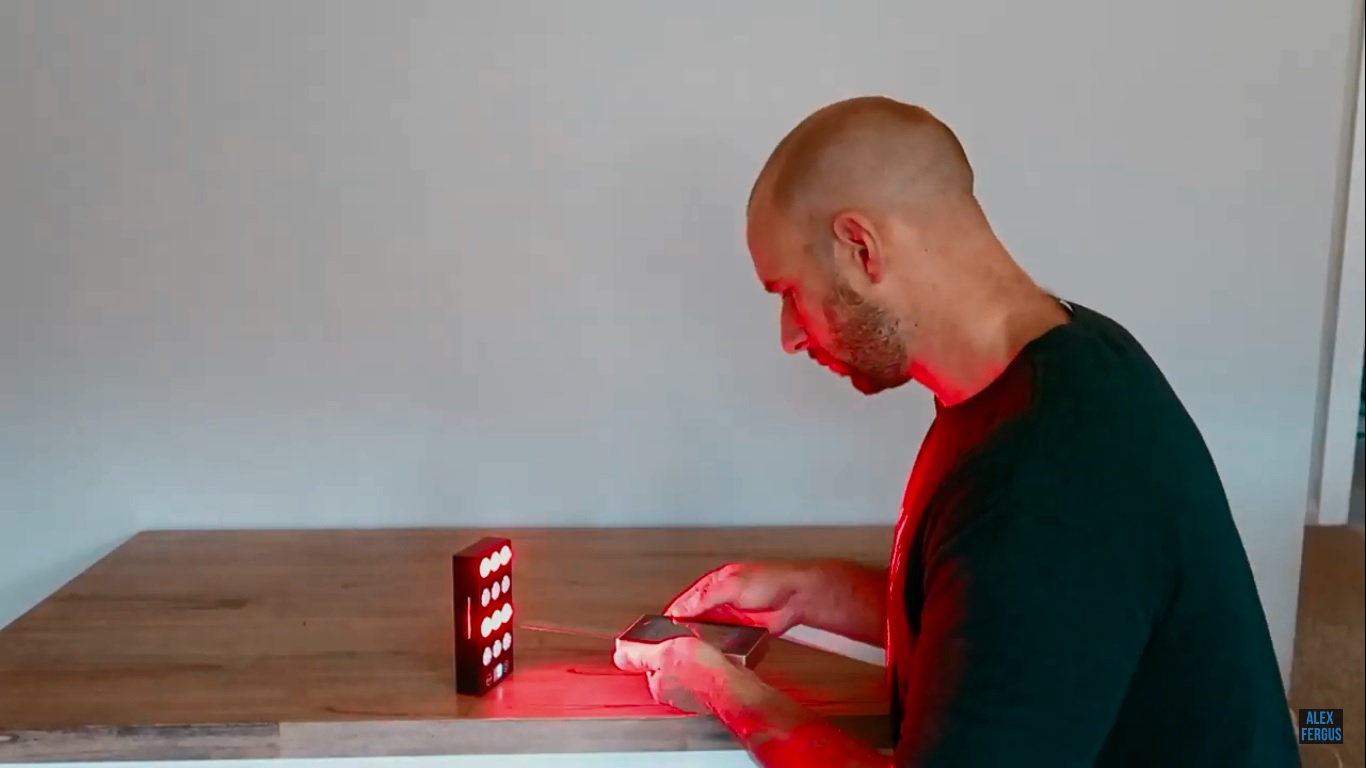
Again, I'm moving horizontally across the panel for all 7 devices.
The power output can subsequently be read off the screen, including information about the wavelengths:
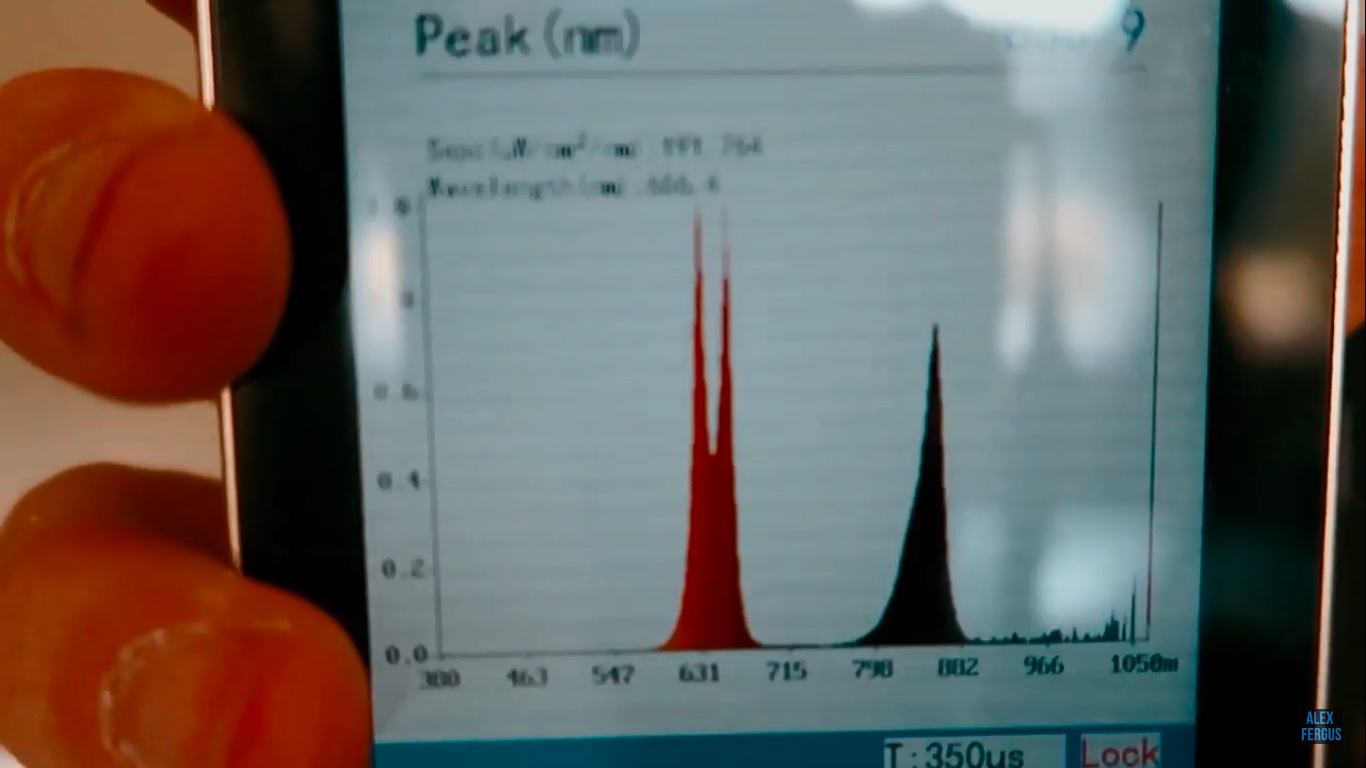
*Apologies the screen is not 100% clear on camera but I can read a power output in mW/cm2 on the top left of my screen!
So what's the peak power output? Here's the outcome of this round:
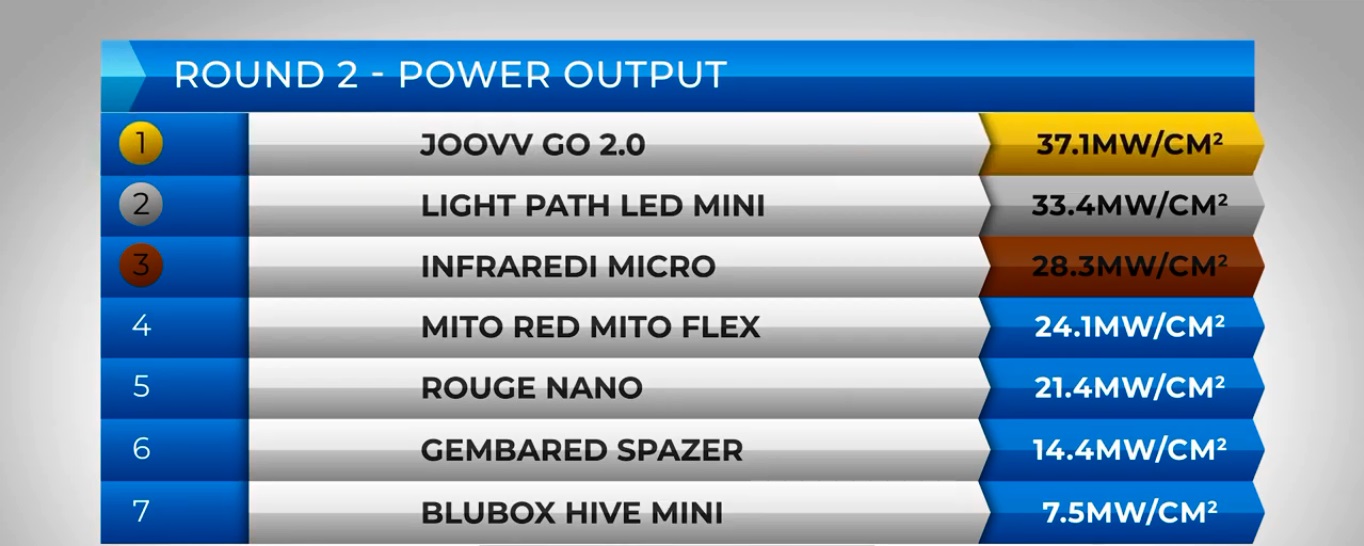
My thoughts?
The best part is that all of the devices are producing the amount of light they're claiming to produce! The same is true for the wavelength profile - so no company claimed their panels emitted 850 while in reality, the spectrometer showed an 830-nanometer peak.
So that's great!
If you're interested in more details, here are the comments I had about some of these panels:
- The GembaRed Spazer has 630 in addition to 660, so there's an additional wavelength included within the test. The power output was still double that of the BluBlox hive but still near the bottom, which is surprising with a device that is powered only though a power outlet and not a battery.
- The Light Path LED has some blue light in there, which can be helpful for skin conditions but should be avoided late in the evening. The Light Path LED measurement also includes the blue light, unfortunately, which messes the reading a bit up. I didn't want to wait several weeks for a new non-blue inclusive unit to arrive though. Most of the power intensity stems from the 660-nanometer range though, not the 530-nanometer blue!
- If you're using the Boncharge (Formerly BLUBlox) Hive, you'd need to use the device for longer to get the same benefit. The Boncharge Hive emits 7.5 mW/cm2
- What's surprising about the Infraredi Micro is that it has a high power output of above 20 mW/cm2, even though it's constructed the same as the GembaRed and the Mito Red.
- The Joovv Go 2.0, while the most expensive, also has the highest power output. So this device is an amazing high-end option if you want to get the max out of your unit!
That's it for this round.
Obviously, due to the power output, the Joovv Go 2.0 is the winner of this round!
Let's move on to a topic that's entering the mainstream more and more - EMF:
Round 3: EMF Levels
For the EMF measurements, I've used the Cornet EMF meter. If you're interested in getting one, click HERE. I recommend the Cornet reader as an excellent option that doesn't cost too much, and is applicable for radio waves & micro waves, magnetic fields, and electric fields.
I've tested all the devices at a 6-inch distance, which is the recommended distance.
Here's the outcome:
...
...
No changes in EMF readings for any device at a 6-inch distance! So, this round is short and easy, nothing to distinguish between all these devices. Hence, I didn't have any device score any points in this round!
Only the Light Path LED and GembaRed has tiny changes in electric field levels, but nothing to worry about. These readings were so low that it's negligible. And, the GembaRed reading probably originates because the device needs to be plugged in to the power grid.
The reason these readings are so low, by the way, is because most of these devices run on a battery (DC current), and none of them have an inbuilt fan.
Moving on to the next round:
Round 4: Battery Life
This round is really simple: I'm testing how long a battery lasts for all of the 7 devices. Of course, this process is impossible for the GembaRed Spazer, so I'm only including the 6 battery-powered devices.
All 6 battery-powered had been charging all night for this experiment.
For this round, I've set a camera up with a timelapse and I've got a laptop clock ticking by. Next, I've turned all the units on and I observe how long they run. For the units that have built-in timers, I've made sure to stay in the room during this test and turn any unit back on that switches off.
Here you can see me in action, turning a unit back on that had switched off:
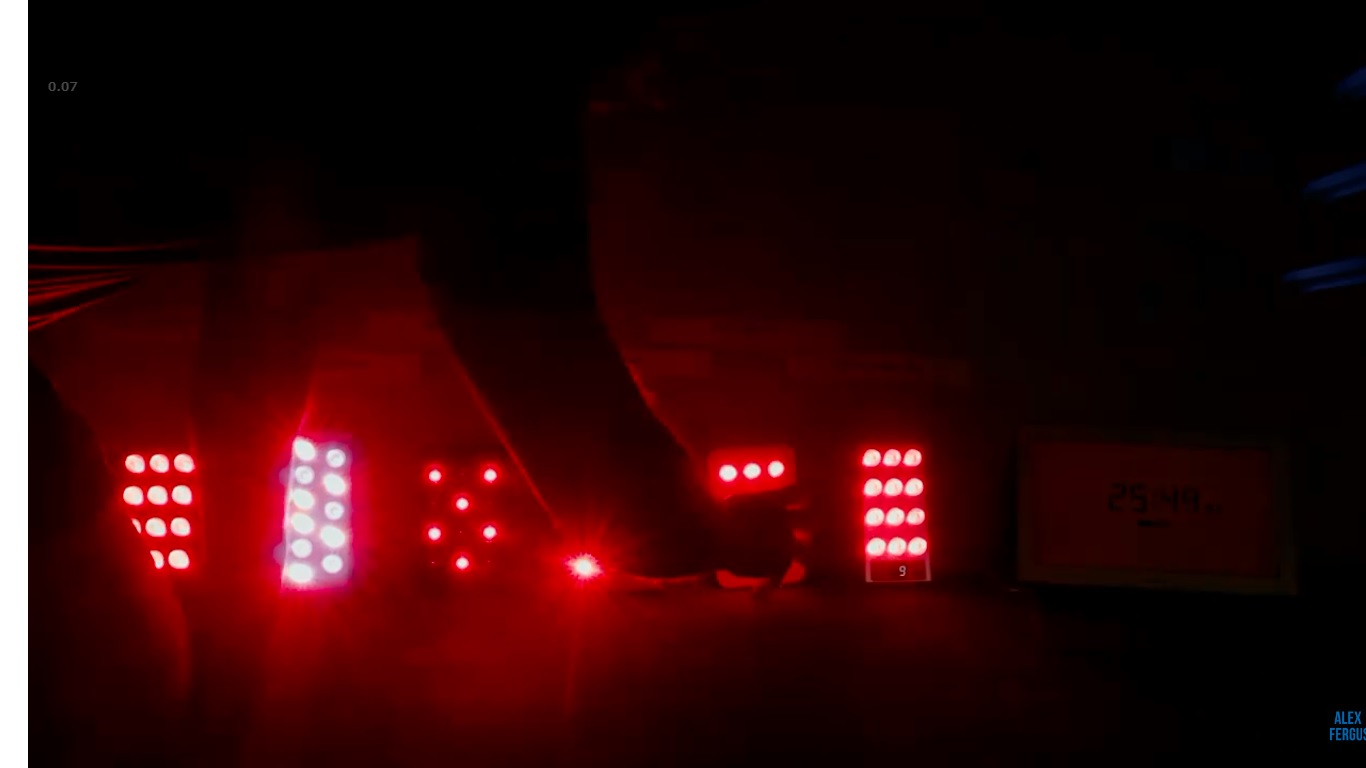
After 2 hours, I quit the test, when 3 devices were still on and 3 ran out of power. I was very busy and was happy with this outcome. The 3 devices that were still on after 2 hours were the Mito Red Mobile Flex, The Light Path LED Mini, and the Infraredi Micro. Therefore, these 3 devices score highest in the battery category.
The Joovv Go 2.0, Boncharge (formerly BLUBlox) Hive Mini and Rouge Nano had switched off before the 2-hour marker.
Remember that 2 hours is more than plenty for any of these devices, which is how I justify my choice to cut off measuring the batteries after that timestamp.
You might be interested in the end results though. So here's the final outcome of this test:

Next up, some comments, where applicable:
- The Joovv Go 2.0 only ran for 1 hour and 15 minutes, even though 2 hours are listed in the manual. The battery indicator also stated that 20% was still left, even though the device shut down. After turning the device back on, I could get only a minute of battery power out of it, and after 5 attempts, the entire device shut down due to low power.
- The GembaRed Spazer gets the lowest score because it doesn't contain a battery. You can get a battery-powered alternative for double the price at Gembared though, but I haven't tested it.
Coming up, the last round of "everything else":
Round 5: Everything Else
Even though it's very difficult to properly allocate points here, I've divided all the panels into two categories:
The top-scoring "everything else" panels, and the low-scoring "everything else" panels. First off, here's the outcome:
 As you can see, there are 3 panels that score 1 point, the Infraredi Micro, the Joovv Go 2.0, and the Mito Red Mito Mobile Flex. These 3 panels make up the "higher-tier" outcome of this round.
As you can see, there are 3 panels that score 1 point, the Infraredi Micro, the Joovv Go 2.0, and the Mito Red Mito Mobile Flex. These 3 panels make up the "higher-tier" outcome of this round.
The other 4 products, which are the Light Path LED Mini, the GembaRed Spazer, The Rouge Nano, and Boncharge (formerly BluBlox) Hive Mini, make up the "lower tier".
Let me comment on the lower-tier (so high-scoring) of the "everything else" panels:
- The GembaRed Spazer is low-scoring because it doesn't have a battery. The price is good though and the device is simple to use and has a great size, but the absence of a battery is a huge downside compared to other devices.
- Secondly, the Light Path LED is quite bulky and heavy, and doesn't have the nice carry case that the other devices have. You cannot select between what lights are working on this device either. The device is also a little bit wider so holding it in your hands for 20 minutes is not the most comfortable for everyone - especially if you're not training like me! I also dislike that there's blue in this device as I wanted to only review red and infrared combination devices.
- Then, thirdly, the Boncharge (Formerly BLUBlox) Hive Mini, is not quite as bulky as the Light Path LED but it's still chunky and thick. I also dislike that there are 3 buttons on the top, 1 button for red light, 1 button for infrared light, and 1 button for the battery. Controlling the unit through these buttons is excessively complicated and the process can be simplified. For Also, you cannot even tell whether the near-infrared light is on by pushing the button. Only visual inspection of a very faint infrared light coming from the LEDs tells you whether infrared is turned on or off. Also, the device does not have timer function, so failure to turn off infrared light can drain the entire battery.
- Fourthly, the Rouge Nano, is very heavy. The power charger is also very bulky. The device is very easy to use, however, with one button on the top of the device. Nevertheless, people who want an option to either use only red light or infrared light, don't have that option with the Rouge. The Rouge simply has fewer bells and whistles - such as no inbuilt timer - than other options. Because of the size and width of this device, and the other downsides mentioned before, I've scored the Rouge Nano in the lower-tier (so highers-scoring) 4-point category.
Then, next up, there are the 3 red light therapy handheld devices scoring only 1 point, as the "higher-tier" of the "everything else" category. In other words, these devices are winners of this round:
- First up, there's the Joovv Go 2.0. The design is very nice and the added handle is a great addon. The Joovv Go 2.0 also has lots of bells and whistles, such as an alarm function whereby the device is synced with your iPhone and the light will wake you up in the morning. Then there's the ambient mode where you can use the device for background lighting - although the mode is not perfect because it's still on a 10-minute timer. The Joovv Go 2.0 also has a pulsing mode that all other devices don't have. Also, there's a BlueTooth function where you can sync the device with your phone, so that you can use your phone to use your personal red light therapy settings. I think the Bluetooth function is a downside and I'd like to have more controls on the device itself though. The case is nice but big but overall the Joovv Go 2.0 has many unique additions.
- Next up, there's the Mito Red Mito Mobile Flex is very light and small, the case is nice, and comes in 3 color options. The device has a timer for 10-minutes, and the option to choose between either red or infrared light, or both. This device is both foolproof and has all the options I personally want. Also, all the LEDs will have maximum output if you only choose 650 nanometer light, or 850 nanometers. The power is split if you choose both wavelengths. The USB charger is also great. The exact same statements are true for the Infraredi Micro, because it's almost the same device!
That's it, the "everything else" round!
Hope you're excited to see the final outcome of this review!
Here I go:
Top Handheld Red Light Therapy Panels & Overall Winner!
Finally, it's time to determine the winner! But before I give you the final outcome let's consider my scoring system:
Scoring System: Weighing The Outcomes Of Previous Rounds
Here's how I've weighted all the outcomes from all the rounds:
- Price: 30%
- Power output: 30%
- Everything else: 30%
- Battery: 10%
Of course, EMF is not included in this list because all devices scored well when I used them from the recommended distance.
Battery only makes up 10% of the equation because all of the devices with a battery lasted at least an hour, which is great! Usually, you don't use the device longer than 10-20 minutes, which entails that you can get at least 3-6 sessions with each of the battery-powered devices.
For most people, charging your device every 3-6 sessions is not too much of a hassle, and many options thus have a longer battery life than that...
So, here's the final outcome:
Final Outcome
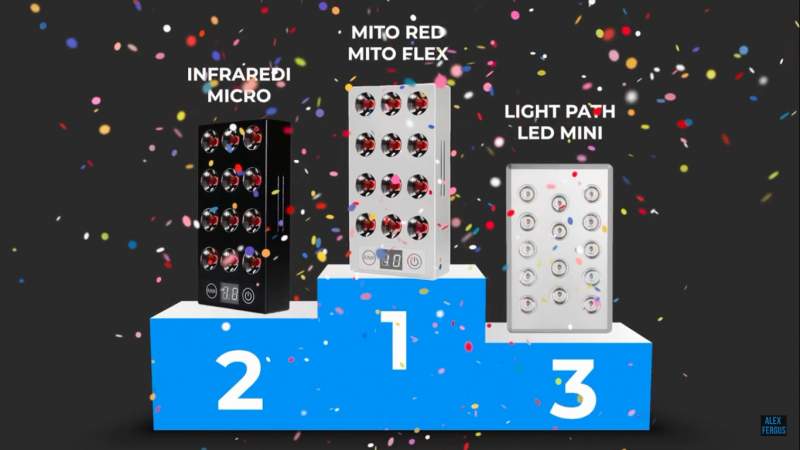
As you can see, the Mito Red Mito Mobile Flex is placed number one, the Infraredi Micro takes second place, and the Light Path LED Mini comes in at third.
Maybe you also want to know what the 4-7th place outcomes are - in that case:

Here's some last comments on some of the devices that I haven't made earlier yet:
- The Boncharge (Formerly BLUBlox) Hive Mini has far lower battery life as some of the other units, and the power output isn't great either. The price is great though!
- An absence of a battery for the GembaRed Spazer is a dealbreaker for me, overall.
- The Joovv Go 2.0 is an exceptional unit but the price really drives the overall score down. There was a 1-point difference between the number 3 and 4 ranking as well, so the Joovv Go 2.0 almost reached the podium!
- Coming in at third place, the Light Path LED, I'm surprised this device did so well. I didn't like the design too much because it's bulky and heavy and harder to use, but, the price is great, the power output is great, and good battery life. The outcome on those 3 categories pushed this device towards the top.
- With regard to first place and second place, the Infraredi Micro and Mito Red Mito Mobile Flex both did really well. What device is best for you depends on whether you want the lowest price, or, the highest power output. There's barely any difference in outcome between these devices because they're engineered the same way. If price is more important for you, get the Mito Red Mito Mobile Flex. If power output is most important and you're willing to spend another $30-40, get the Infraredi Micro. Both devices are easy to navigate/use and foolproof, with all the correct bells and whistles.
Overall though, I do want to reiterate that there's no bad panel out that I've reviewed. All of the panels achieved the power output they claimed to have by the manufacturers.
So, eventually, what panel is best for you depends on your unique circumstances. If you don't care about price and want the most powerful unit, get the Joovv Go 2.0. If you want a great deal with good power output, get the Infraredi or Mito Red unit.
Heck, if you prefer plugging in the device into a wall and don't want the complication of a battery, get the GembaRed Spazer!
So here's some of the minor rewards:
Minor Handheld RLT Awards 2021
After I've chosen the #1 overall, let's consider a few more options depending on your preferences. Here's my ranking for the "minor" awards:
- Best for Pure Power
The Joovv Go 2.0 has a power output of 37.1 mW/cm2 which is 10% higher than the number 2 in power output and almost 5 times as high as the bottom handheld panel!
- Best for those on a Tight Budget
Here I will recommend the GembaRed Spazer if you're willing to buy a device that's not battery powered.
- Best for Maximum Battery Capacity
Well, 3 panels had the highest score on the battery test, so which one would I choose? Of course, here I'll choose the Mito Red Mito Mobile Flex because it has the highest overall score, all things considered!
- Best for Most Bells and Whistles
This one is easy too, the Joovv Go 2.0 has some pretty neat options that other panels don't have, such as the ability to connect it to your phone and use the device as ambient lighting.
- Best for a wide range of Wavelengths
The GembaRed Spazer has one more wavelength that the other panels don't have: 630 nanometers red light, so if you want more red light options, this can be your best choice!
- Best for Australian customers
This one is easy. There's only one company stemming from Australia: Infraredi. So if you're an Australian customer and don't want to pay for shipping, consider the Infraredi Micro. As the panel also came in at second place, this is an excellent option for Aussies!
- Best for Skin Health benefits
There is some research suggesting blue light can help your skin improve in texture and overall health. Again, the Light Path LED offers a device that includes blue light and yet still emits tons of red light. Only use blue light during the daytime.
Hopefully, my review has made your choice easier and has informed you better about what options exist out there in the handheld red light therapy space.
Also, to get access to the best deal, make sure to read the next section:
Don't Forget To Save With Discount Code ALEX
In order for me to fund these reviews I'm affiliated with every single company out there that wants to work with me. Through that method, I remove as much bias as possible from the process.
Discount code ALEX will give you a nice lower price with almost all of these companies. That lower price is a win/win for both of us because you get a discount and I get a small commission to fuel these review rounds.
Below, in the list of items mentioned you can view all the panels with their discount code - if available - as well as my my testing equipment (EMF meter, spectrometer, etc):
Items Mentioned
- Hopoo Color 0HSP-350F - 380-1050nm Spectrometer
- Cornet EMF meter
- Infraredi Micro - discount code ALEX saves
- Light Path LED Mini - discount code ALEX saves
- Boncharge (Formerly BLUBlox) Hive Mini - discount code ALEX saves
- Rouge Nano - discount code ALEX saves
- Joovv Go 2.0 - no discount code available, unfortunately!
- Mito Red Mito Mobile Flex - discount code ALEX saves
- GembaRed Spazer - discount code ALEX saves
Want More Video Input? Watch My Early Info On The 2021 Full Body Panel And My Joovv Go 2.0 First Impressions Video & More Below:
First, my 2021 full body panel red light therapy update:
asdf
Secondly, my first impressions video of the Joovv Go 2.0:
Thirdly, my 2019 full body panel review:
Fourthly, my 2021 handheld panel review once more - for if you prefer video over the written word:
Found This Interesting? Then You Might Like:
- Red Light Therapy Resource & Discount Page
- Everything You Need To Know About Red Light Therapy
- 36 Powerful Red Light Therapy Benefits
- How To Increase Deep Sleep
This blog post was written by Alex Fergus. Alex is a ISSN Sports Nutrition Specialist, Fitness Professional and certified Superhuman Coach who continues to expand his knowledge base and help people across the world with their health and wellness. Alex is recognized as the National Record Holder in Powerlifting and Indoor Rowing and has earned the title of the Australian National Natural Bodybuilding Champion. Having worked as a health coach and personal trainer for over a decade, Alex now researches all things health and wellness and shares his findings on this blog. Learn more about Alex's Credentials HERE.
Get FREE Updates & EXCLUSIVE Content
Join Over 30,000+ Subscribers!








